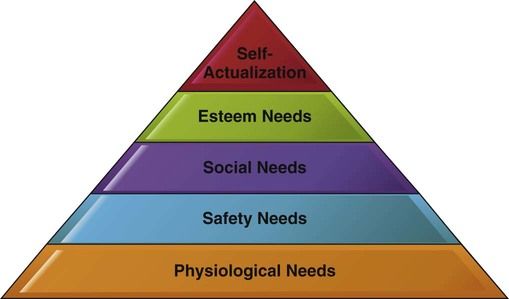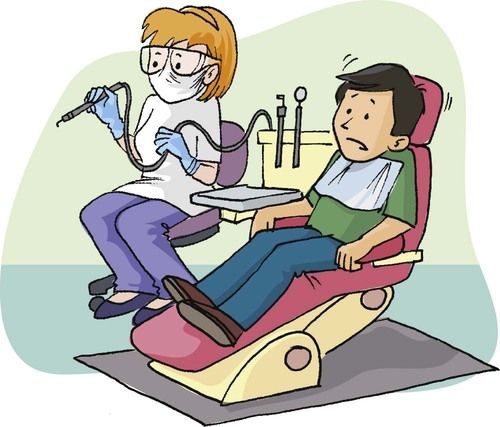Practice Note
The most important person in the dental practice is the patient.
Maslow’s Hierarchy of Needs
Dr. Abraham Maslow has described a hierarchy of needs (Figure 3-1) that aids in the understanding of how a person’s needs motivate his or her behavior. Maslow identified the following five basic levels of needs, which range from basic biologic needs to complex social or psychologic drives:

Relating this hierarchy to dentistry means getting to know the patients and the individuals with whom one is associated. Before a dentist can motivate a patient to accept a certain type of dental treatment, it must be understood where the patient is on the hierarchy of needs.
To help realize the application of these needs to dentistry, consider the following situation. One of the practice’s patients is a bank president who is respected for his civic activities and who has a warm, loving family and a fine home. The patient develops severe pain in the maxillary anterior area that is sudden, sharp, and excruciating. It is difficult for him to eat, and there is a great deal of swelling in his upper lip. This person has dropped from the esteem level to the physiologic or biologic level, and the dentist must satisfy the pressing physiologic need immediately before attempting to suggest any further treatment.
Setting up a payment plan for a patient often exposes a conflict of needs. A patient must ensure that his or her basic needs of food, housing, and clothing are met, yet there may be a desire to meet social needs by improving his or her appearance with some form of dental treatment. A conflict arises during the decision-making process when the patient is confronted with a conflict involving how to satisfy all of these needs with a specified income. The dentist and staff must make an effort to determine the patient’s needs, to realize the patient’s potential conflict, and to consider presenting an alternative treatment plan so that the patient has some options.
This theory need not only apply to relationships with patients; it can also be applied to interactions among staff members. The dentist, the assistant, and the hygienist all have the same needs, and each is concerned—like the patient—about his or her security today and in the future. Often conflict arises when a person becomes fixed at one level. There may appear to be no change in motivation, and the person remains unchanged in his or her perspective. This is often evidenced when a person has an interest in making money or increasing his or her social status without regard for other people’s levels of motivation.
Perhaps one of the best lessons to be learned from Maslow’s theory is that an individual has a choice in determining his or her behavior. Although basic physiologic and environmental needs have strong influences, an individual makes his or her choices voluntarily.
Rogers’ Client-Centered Therapy
Dr. Carl Rogers, another humanistic psychologist, believed that “it is the client who knows what hurts, what directions to go, what problems are crucial, what experiences have been deeply buried.” Rogers also suggests accepting the patient or the other person as a genuine person with his or her own set of values and goals and states that these people must be treated with “unconditional positive regard.” Client-centered therapy assumes that patients know how they feel, what they want, and their priorities. When applied to dentistry, this philosophy encourages the dentist and staff to listen to the patient. In addition, this concept suggests respecting patients as human beings and not just as numbers, case studies, or research projects. Patients have needs, and their desires should not be repressed. The combined concepts of Maslow and Rogers provide the groundwork for a humanistic, caring attitude that should be a requisite for all healthcare providers.
Locus of Control
A person’s locus of control is the degree to which that person feels that he or she has control over the events that occur in his or her life. At one end of the spectrum are individuals who believe that life events “just happen” or are determined by destiny, fate, or chance (external locus of control). At the other end of the spectrum are people who believe that life events are determined by their own actions (internal locus of control).
The locus of control theory was developed in 1954 by psychologist Julian Rotter. He suggested that our behavior is controlled by rewards and punishments, and it is the consequences of our actions that determine our beliefs. Rotter published a scale designed to measure and assess a person’s external and internal loci of control.
A health-specific version of Rotter’s scale, The Health Locus of Control, was developed in 1976 by Wallston and colleagues. It examines the degree to which individuals believe that their health is controlled by internal and external factors. Individuals who have had successful attempts at health control are more likely to have internal loci of control than individuals who have been unsuccessful in their attempts.
A person with an external locus of control is more likely to believe that the dentist has control over his or her oral health or that his or her oral health has been predetermined by fate. This type of patient may state, “I’m sure I will need dentures, because my mother and father both had dentures.”
The patient who is proactive in the care of his or her mouth is more likely to have an internal locus of control. An example of this would be the patient who follows directions and applies new techniques to improve his or her oral health. This type of patient may say, “I’ll try that electric toothbrush and see if I have less plaque at my next visit,” or “I want to get that implant placed before I lose any more bone.”
Specific questions that can be asked at chairside can help to determine a patient’s personality orientation toward an external or internal locus of control:
Box 3-1 lists the range of personality characteristics demonstrated by individuals on the spectrum from an external locus of control to an internal locus of control.
For the dental professional, this study becomes helpful when motivating staff and patients to perform various tasks. For instance, if a patient insists that he or she is not able to brush his or her teeth more than once a day, then alternatives need to be presented to encourage that patient to use techniques that will help him or her to remove plaque and maintain a healthier mouth. If a staff member insists that he or she is not capable of placing an intraoral sensor in a patient’s mouth, then some practice could be provided on a typodont or manikin to help him or her improve this skill.
An internal locus of control is often associated with the concepts of self-determination and personal agency. Research has suggested that males tend to be more internally focused than females. As people age, they tend to become more internal, and people with higher organizational structures also tend to be more internal.
However, it is also important to remember that internal does not always imply “good” and external does not always equate to “bad.” In some situations, an external locus of control can actually be a good thing, particularly if a person’s level of competence in a particular area is not very strong. There are cautions that need to be considered when using this model, and, within the limited space of this text, it is not possible to discuss all of the factors involved in considering the internal and external loci of control without being overly simplistic. For more information about this concept, it would be wise for the reader to consult some of Rotter’s research.
Barriers to Patient Communication
Common Obstacles
Often practitioners are unable to communicate with patients because barriers have been established. One of the first barriers that may be created is prejudging a patient. A dentist may hesitate to present an extensive treatment to a patient because of the way the patient dresses or the type of car he or she drives. As a result, the patient is never told about alternative forms of treatment, because his or her economic status has been prejudged. Often a person with a disability is prejudged. When a patient who has an artificial limb, who is in a wheelchair, or who has a visible birthmark on his or her face enters the dental office, frequently the first noticeable feature is the disability. If this patient is with a spouse or another person, the patient may go unnoticed while questions are directed to the accompanying person. As a dental healthcare worker, it is important to treat people with disabilities as you do any other patients and to direct all communication to the patient himself or herself.
Another barrier occurs when one hears but does not listen. A dental professional should never be too busy to listen with understanding to a patient. It is important to do more than just listen to the words; one must listen to the meaning of the words and the feeling behind the meaning. Before presenting a personal point of view, you must be able to restate what the patient has said to the patient’s satisfaction. This may sound easy, but often it is not. People are frequently too eager to present their own point of view, and they fail to understand the real meaning of what the other person is attempting to say. What is the patient really saying when he or she says, “I think I’ll wait to have that treatment done”? If the dental professional responds, “Oh, that’s okay, Mrs. Gates, I understand,” then he or she will not know what the patient is really saying and may cut off communication. The patient may really be saying, “I’m scared,” “I can’t afford it,” or “I don’t like the way you treat me.” The best way to arrive at the real meaning is to continue the dialogue until the patient’s true feelings are discerned. The following example demonstrates this idea:
Assistant: “Do you want to wait because you are too busy now?” (The patient may say yes and terminate the conversation at this point, or the conversation may continue.)
If the patient says “Yes,” the assistant may reply as follows:
Assistant: “Mrs. Romano, we understand busy schedules, and we do value your time. We can custom design your appointments just as we design a personalized treatment plan. Why don’t we take a look at your schedule and see if we can work together to find time for your treatment?”
Alternatively, there may be a financial reason behind the patient’s decision:
Patient: “No, it’s just that I don’t know if I should spend that much money, because I have so many other expenses right now.”
Assistant: “Mrs. Romano, we know how budgets can be stretched today, and we can work with you to help you afford this investment, which is going to pay dividends over the next 10 to 20 years.”
At this point, the assistant could explain the financial arrangements that can be made in the office.
Notice in this dialogue that the assistant offered a solution to the problem so that it could be discussed further.
However, the dialogue may have continued along different lines, as shown in the following example:
Patient: “Well, it’s not that I can’t afford it. I guess what it boils down to is that I’ve never had that type of treatment, and I’m not sure what it’s going to involve.”
Patient: “Yes, I guess that’s it. I’m really a bit skeptical about what’s going to happen.” (At this point, the hidden meaning becomes evident.)
In this case, the assistant rephrased what the patient said to arrive at the real meaning.
A third barrier is preoccupation. During daily routines, many demands are placed on one’s time, and it is easy to begin to suddenly think about other activities while trying to communicate with a patient. Everyone has been in that position at one time or another. A patient is trying to explain why an appointment time is not convenient, and suddenly the dental professional realizes that she or he has not heard a word that was said because of his or her concentration on another problem. This often happens in an office that is understaffed. Each staff member has so much work to accomplish that listening to a patient sometimes just becomes an additional burden. Unfortunately, patients are quick to recognize such preoccupation, and they may suddenly stop talking, or eventually they may even stop coming into the dental office. This type of situation reemphasizes the service model illustrated in Chapter 1. As mentioned previously, the patient is the most important person in the dental office and should be given complete attention.
Unawareness of importance, impatience, and even hearing loss are barriers to communication. How important the problem is to the patient may not be realized, and the patient’s concern may simply be ignored as a whim. Likewise, one may inadvertently become impatient with a chatty young child or an older person who is slow. It is also possible that a dental staff member may not hear everything a patient says because of an unrealized hearing loss.
It is not beneficial just to know about these barriers: the dental professional must be willing to evaluate his or her own behavior as it relates to them. Before each contact with a patient, the staff member must decide to ignore extraneous activities and be willing to listen to and understand the patient’s problem before offering a solution.
Recognizing Nonverbal Cues
In recent years, many books have been written to define and guide the reader toward recognizing nonverbal communication cues. Nonverbal cues refer to the gestures and body movements that a person makes in a given situation.
Every member of the dental staff should have some awareness of this area. Just as “a picture is worth a thousand words” so may a gesture give meaning to a person’s inner feelings. Nonverbal communication provides feedback regarding the patient’s true reactions.
The alert assistant is able to pick up these cues and interpret them while communicating with the patient. Care should be taken to not be misled by one gesture. A series of gestures generally gives a more realistic indication of a person’s attitude. A dental office presents many opportunities for the use and receiving of nonverbal cues.
Nervousness
A patient who enters the reception room and sits down, locks his or her ankles together, and clenches his or her hands may be expressing fear by holding back emotions (Figure 3-2). This may occur in the dental chair, when a person clenches the armrests and locks the ankles together (Figure 3-3). When the patient relaxes, he or she will automatically unlock the ankles.
Stay updated, free dental videos. Join our Telegram channel

VIDEdental - Online dental courses




